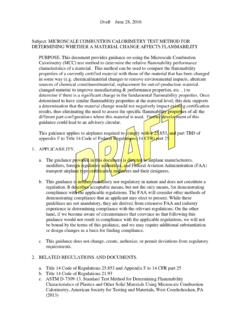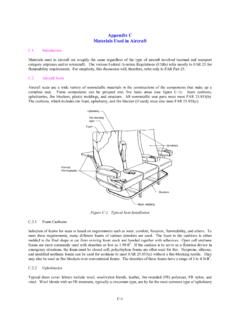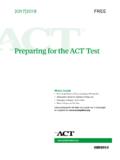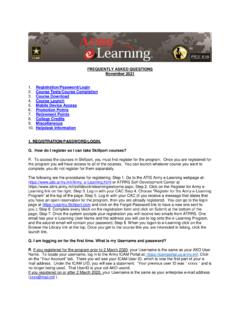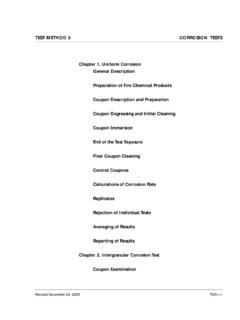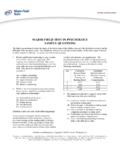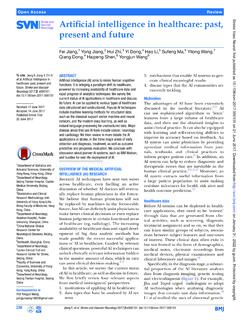Transcription of LITHIUM BATTERY FIRE TESTS
1 LITHIUM BATTERY FIRE TESTSH arry WebsterFAA William J Hughes Technical There have been several incidents involving both LITHIUM primary (non-rechargeable) and LITHIUM -ion (rechargeable) batteries Aircraft Cargo Fire April 99 (LAX) Dropped pallet of LITHIUM primary batteries on ramp caught fire No external ignition sourceBACKGROUND FEDEX Memphis incident A shipment of LITHIUM -ion batteries were placed in a cargo container and loaded into a FEDEX aircraft The handlers smelled smoke and determined it was coming from the cargo container The container was off loaded from the aircraft and burst into flames on the ramp NTSB investigation determined the source of the fire was the LITHIUM BATTERY shipmentPrimary BATTERY Major Findings A relatively small fire source is sufficient start a LITHIUM BATTERY fire The ignition of a single BATTERY produces enough heat to ignite adjacent batteries Halon 1301 is ineffective in suppressing a LITHIUM BATTERY fire Batteries of the same type but from different manufacturers exhibit varying flammability characteristicsPrimary BATTERY Major Findings (2)
2 Halon 1301 chemically interacts with the burning LITHIUM and electrolyte-with no effect on fire intensity Cargo liner is vulnerable to penetration by molten LITHIUM Batteries fuse together when exposed to flame, promoting propagation between batteriesPrimary BATTERY Major Findings (3) The temperatures found in a suppressed smoldering cargo fire are sufficient to ignite a primary LITHIUM BATTERY The pressure rise due to BATTERY ignition is sufficient to compromise the integrity of a cargo compartmentREPORT PUBLISHED Flammability Assessment of Bulk-Packed, Nonrechargeable LITHIUM Primary Batteries in Transport Category Aircraft by Harry Webster, June 2004 DOT/FAA/AR-04/26 Report can be found at: Interim Final Rule Issued Prohibition on the Transportation of Primary LITHIUM Batteries and Cells Aboard Passenger Aircraft 49 CFR Parts 171, 172, 173 and 175 [Docket No. RSPA-04-19886 (HM-224E] RIN 2137-AE05 prohibits primary LITHIUM BATTERY cargo shipments on passenger carrying aircraft Federal Register, December 15, 2004, Page 75208 LITHIUM -Ion BATTERY Flammability TESTS HM-224E: RSPA and the FAA will continue to study the hazards associated with the transportation of secondary (rechargeable) LITHIUM batteries and will initiate additional actions as necessary.)
3 Investigate flammability characteristics, Extinguishing system effectiveness, BATTERY charge state, BATTERY failure modeLithium-Ion BATTERY Types Initial testing will be done with 18650 type cells routinely used to power laptop computers Additional TESTS may be done with flat prismatic cells used in cell phones TESTS will be conducted at 100% and 50% chargeTest Conditions The same 64 cubic foot test chamber used for the primary batteries will be used Batteries will be subjected to small alcohol fires Data will include chamber temperature and heat flux measurements and each test will be documented with video coverage Pressure rise will be measured in the Pressure Modeling FacilityTest Conditions (2) Batteries will be tested singly and in groups Halon effectiveness TESTS will be conducted at 5% and 3% concentration Oven TESTS will be conducted to determine the auto-ignition temperatureLithium-ion Test Results LITHIUM 18650 cells were provided byfivedifferent manufacturers.
4 Cells were delivered in two states of charge Normal shipping charge, approximately 50% Full charge (100%)Typical 18650 CellLithium-ion Test Results TESTS were conducted at both 50% and 100% charge in the 64 cubic foot chamber with 1, 4, 8 and 16 cell groups. Cells were exposed to a small alcohol fire Video, temperature and heat flux data was collectedLithium-ion Test Results Typical 50% charge cell response to alcohol fire: Initial pressure relief through positive terminal blow out vent ports, small amount of liquid released. Liquid is flammable and readily burns when exposed to the alcohol fire 20-30 seconds later, liquid electrolyte is forcefully vented through the positive terminal vent ports. This liquid is highly flammableLithium-ion Test Results Typical 50% charge cell response to alcohol fire (cont d): Propagation: the heat generated by the cells that vented electrolyte would often ignite adjacent cells even after the alcohol fire had exhausted its fuel and gone out Explosion: occasionally, a cell did not vent, and instead exploded forcefully, expelling the entire contents of the cell from the casing Fire ball from electrolyte mist Large pressure pulseLithium-ion Test Results Typical 100% charge cell response to alcohol fire Initial pressure relief through positive terminal blow out vent ports, small amount of liquid released.
5 Liquid is flammable and readily burns when exposed to alcohol fire. Vent release much more forceful than at 50%. 20-30 seconds later, liquid electrolyte is forcefully vented through the positive terminal vent ports. This liquid is highly flammable and included small white sparks sprayed out with the electrolyteLithium-ion Test Results Typical 100% charge cell response to alcohol fire (cont d): Propagation: the heat generated by the cells that vented electrolyte would often ignite adjacent cells even after the alcohol fire had exhausted its fuel and gone out Explosion: more common than at 50%, a cell did not vent, and instead exploded forcefully, expelling the entire contents of the cell from the casing. Event was more forceful at 100% charge. Fire ball from electrolyte mist Large pressure pulse18650 Cell after exposure to alcohol fireRemains of exploded cell5% and 3% Halon Extinguisher TESTS TESTS were conducted with groups of 8 batteries,the Halon system was discharged at either the initial first event or second event.
6 Batteries were tested at both 100% charge and 50% charge. Halon immediately extinguished the pan fire in each case, removing the heat and 3% Halon Test Results Halon extinguished the burning electrolyte from both first event fires and second event fires Halon discharged at first event prevented any additional venting or explosion by removing the heat source before the batteries reached critical temperature Halon discharged at the second event did not prevent additional batteries from venting, but the electrolyte did not catch fire. The test article filled with electrolyte gas. At 100% charge, white sparks can still be seen. 3% was just as effective as 5%Cargo Liner Exposure TESTS Each test was conducted using 4 cells bound together and secured horizontally so that the positive terminals were 3 from the vertical cargo liner Batteries were tested at both 50 and 100% charge. Thin wall (single layer) liners were testedCargo Liner Exposure Test Results 50% charge. The burning electrolyte charred the liner, but did not penetrate 100% charge The burning electrolyte and small sparks had no effect on the liner other than charring One BATTERY exploded and impacted the liner, knocking it off the stand, but did not damage the linerPressure Pulse TESTS TESTS were conducted in a sealed 10 m3 steel chamber.
7 Batteries were tested at both 50 and 100% Batteries were tested individually and in groups of four. The chamber air temperature and pressure were measuredPressure Pulse FacilityPressure Pulse Results Cargo compartments are designed to equalize pressure at about 1 psi differential A single BATTERY raises the pressure in the nearly airtight 10 m3 facility psi Four batteries can raise it as much as psi A single exploding BATTERY can raise the pressure psiTypical Pressure Pulse Test Facility Insulated steel one foot cube, with removable lid Cells suspended in center of box Heat applied to bottom of box Temperature measured at midpoint and near top of boxOven Test FacilityOven Test Results Cells vented at 470-500 DegF Heat was released during both first and second event venting The electrolyte gas occasionally exploded due to hot surface ignitionTypical Oven Test ResultsTest 86: Sanyo High Capacity, 50% Charge, Oven/Box Test010020030040050060070080011733496581 9711312914516117719320922524125727328930 5321337353369385401417433449465481497513 529545561577593609 Time (Seconds)Temperature ( F)TC TopTC BottomConclusions Heated cells vent flammable electrolyte gas Cells begin venting at approx 470 DegF Halon 1301 easily extinguishes the electrolyte gas fire, even at 3% conc.
8 LITHIUM -ion cells pose no undue threat to cargo liner material Cells produce a pressure pulse when venting As little as four cells can raise the pressure in a sealed 10m cubed chamber by one psi. Compared to primary cells, there is no molten LITHIUM and the cell fires are controlled by Halon Draft report is completed.


